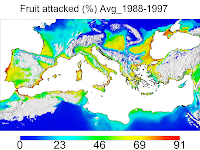Mediterranean-wide analysis of the olive-olive fly system

The Mediterranean Basin is expected to be particularly vulnerable to climate change including pronounced climate warming and desertification. Olive (Olea europaea) is of eco-social importance in the Mediterranean where it was domesticated, and it is also considered a sensitive climate indicator. This crop and its major pest, the olive fly Bactrocera oleae are a suitable model system to study Mediterranean climate. A weather-driven physiologically-based demographic model (PBDM) of olive and olive fly (http://cnr.berkeley.edu/casas/) is being used to analyze this plant-pest system in the Mediterranean region based on ERA-40 weather data (http://www.ecmwf.int/) downscaled via the regional climate model RegCM3 coupled to the MIT ocean model. PBDM predictions are mapped with the open source GIS GRASS (http://grass.osgeo.org/).
Ponti L., Gutierrez A.P., Ruti P.M., 2009. The olive–Bactrocera oleae system in the Mediterranean Basin: a physiologically based analysis driven by the ERA-40 climate data. 5th Study days “Models for Plant Protection”, Piacenza, Italy, 27-29 May 2009.
http://www.grimpp.it/v_giornate_di_studio.htm


Comments
Post a Comment